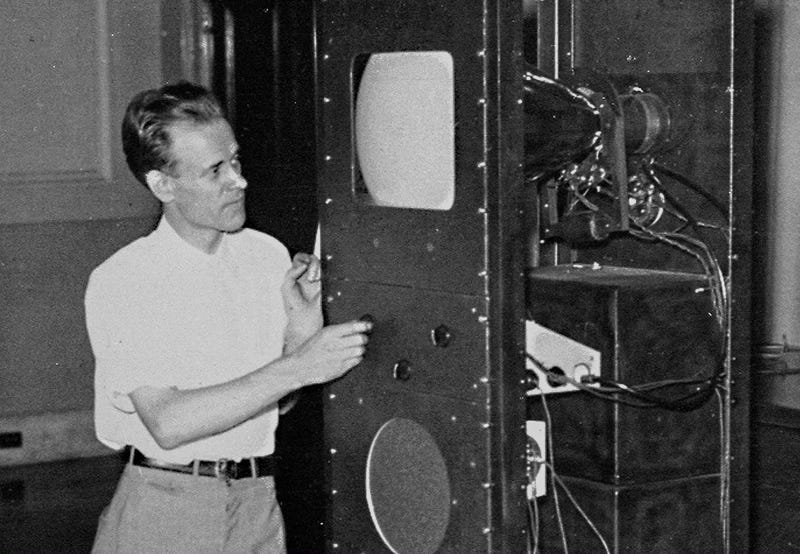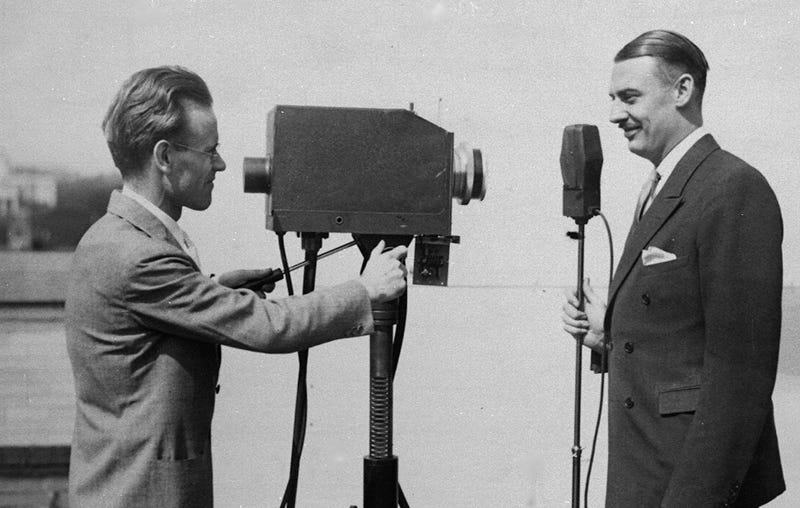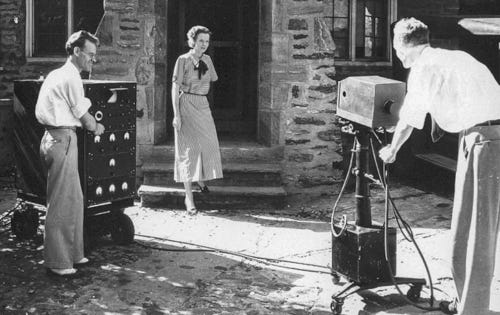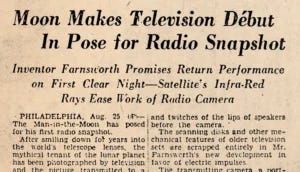Countdown #99 - The Franklin Institute, 1934
In which the public gets its first look at the thing they will be looking at.

(If you prefer a conventional podcast edition, click here and follow the links to “wherever you get your podcasts” to subscribe)
_____________________
(Sometimes I feel like the curator of the warehouse at the end of Raiders of the Lost Ark. Here’s the latest find from deep recesses vaults, aka #99 to the Countdown to the Centennial of Television in September 2027):
_____________________
Television: The State of The Art In 1934
In the 1930s, video technology evolved rapidly in a world-wide race to deliver television to the marketplace.
In the United States, the principal contestants were the giant Radio Corporation of America and a tiny company spearheaded by the wunderkind inventor from Utah by way of San Francisco, Philo T. Farnsworth.
It wasn’t called THE Radio Corporation for nothing. RCA had the capital, the technical resources, and the market clout to extend its dominance in all things radio into the nascent new industry of television.
All Farnsworth had were the fundamental patents for the technology that made the new medium possible.
But RCA was not willing to concede any ground without a long and drawn out fight over those patents.
Both companies had introduced technical improvements, but from 1927 on every new technical development in the art of television followed in the wake of the patents that were granted to Farnsworth in 1930.
From its crude beginnings on a workbench in San Francisco, perfecting electronic video was a complex engineering challenge. After seven years of accelerating progress, television was on the verge of claiming its rightful place in the living rooms of the world.
Into The Belly Of The Beast
Farnsworth relocated his operations from San Francisco to Philadelphia in 1931; RCA’s labs were set up at the old Victor Talking Machines plant across the Delaware in Camden, NJ. Each could see the others’ progress in experimental broadcasts from either side of the river.
[caption id=”attachment_1089” align=”aligncenter” width=”500”]
In the spring of 1934, Farnsworth’s company – rather than capitalizing on its inventions – was mired in litigation with RCA. Farnsworth’s investors were anxious to get a return on their now-substantial investment. RCA, with its boundless resources, was in no hurry to surrender the field.
In this contentious climate, Farnsworth accepted an invitation from the prestigious Franklin Institute of Philadelphia to conduct the world’s first full-scale public demonstration of television in the summer of 1934.
For the occasion, Farnsworth put everything he had learned into a television system suitable for public viewing. His team fabricated a cathode ray tube receiver the size of a ten-gallon jug, and a camera surprisingly compact even by today’s standards.
The exhibit was an unprecedented success. There was little advance publicity – only word-of-mouth – but people lined up for blocks when the doors opened in August. The response was so strong that the event, originally scheduled to last ten days, went on day and night for three weeks.
The Disembodied Image
The power of the new medium was demonstrated at the door: Farnsworth placed a camera near the door, and visitors were immediately confronted by their own disembodied image flickering on an equally strategically placed receiver.

Absent an advance lineup, programs were thrown together on the fly and transmitted from the roof of the Institute to an auditorium downstairs. Vaudeville acts, popular athletes, and a swarm of politicians volunteered to appear before Farnsworth’s cameras.
The ‘content’ hardly mattered to the audience that assembled in fifteen-minute intervals. The crowds came to witness the realization of the ancient dream of seeing at a distance. For the depression-weary populace, this was a visible, tangible oracle of better times to come.
This Paramount Newsreel is from 1936 – two years after the Franklin Institute exhibition – but offers a pretty good look at how far the technology had come in a relatively short time.
______________________________________







I read the book in 2019. I even had Amazon mail a copy of it to the chief judge of the 2nd Circuit Court of appeals in New York City Robert A. Katzmann. Philo was incredibly intelligent. I also had his wife’s Pem book Distant Vision.
In 1938 in Ireland, a 28-year-old woman named Charlotte Keppel invented The Chronoscope. Irish filmmaker Andrew Legge directed the 2009 film of the same name. It’s on YouTube. The Chronoscope shows images of the past.